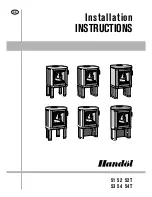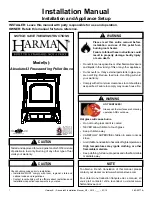
valve compartment, burners and circulating
appliance and to replace any part or control
system and any gas control which has been
permissible only if the tank is disconnected,
removed from the camp stove and properly
non-combustable, level surface. An asphalt
Keep all electrical cords away from a hot
camp stove.
Do not use camp stove for indoor cooking
or heating. TOXIC fumes can accumulate
and cause asphyxiation.
After a period of storage and/or nonuse,
check for leaks and burner obstructions.
Always use a meat thermometer to ensure
food is cooked to a safe temperature.
Never cover entire cooking area with
aluminum foil.
Do not store a spare LP gas tank under or
near this appliance.
Use protective gloves when assembling this
product.
Do not force parts together as this can
result in personal injury or damage to the
product.
Death, serious injury or damage to property
may occur if the above is not followed
exactly.
Assembly Instructions
For Easiest Assembly:
M
To avoid losing any small components, assemble
your product on a hard, level surface that does
not have cracks or openings.
M
Clear an area large enough to layout all
components.
M
Follow all steps in order to properly assemble
your product.
To complete assembly you will need:
M
(1) Leak Detection Solution (Instructions on how
to make solution are included in “Operating
Instructions” section)
M
(1) 14.1 oz LP gas tank.
Typical assembly: approximately 5 minutes.
1. Attach Cooking Grid
2. Attach Regulator
3. Storage of Regulator When Not In Use
Operating Instructions
This camp stove is designed to operate with a one
pound 7-3/8” high disposable / 14.1 oz. propane gas
tank (DOT 39 Cylinder).
DO NOT ATTEMPT TO REFILL ANY ONE POUND
(14.1 oz.) PROPANE GAS TANKS!
Connecting Gas Tank
1. Make sure the control knobs are in the “OFF”
position. (Figure 1)
2. Lubricate the threads of the regulator valve
with petroleum jelly, insert the gas tank into the
regulator valve and hand-tighten firmly. (Figure 2)
3. LP gas tank must be kept at a 45º angle. (Figure 3)
4. Test for leaks.
To maximize use and prevent damage to the
camp stove and it’s components, you must
keep the LP gas tank a 45 degree angle. Not
doing so will void your warranty.
Checking for Leaks
Burner Connection
1. Make sure the regulator is securely fastened to the
burner. (Figure 4)
If your unit was assembled for you, visually check
the connection between the burner and regulator.
WARNING: Failure to inspect this connection or
follow these instructions could cause a fire or
an explosion which can cause death, serious
bodily injury or damage to property.
2. If the burner pipe does not rest flush to the
regulator, please contact 1.800.762.1142 for
assistance.
Regulator / 1lbs. LP Gas Tank Connection
1. Make 2-3 oz. of leak solution by mixing one part
liquid dishwashing soap with three parts water.
2. Make sure control knob is “OFF”. (Figure 1)
3. Spoon several drops of solution, or use squirt
bottle, at the burner to regulator connection and the
LP gas tank to regulator connection. (Figures 4 & 5)
4. Inspect the solution at the connections, looking
for bubbles.
If NO bubbles appear, the connections are secure.
If bubbles appear, you have a leak.
a. Loosen and retighten the connections, making
sure the connections are secure.
b. Retest with solution.
If you continue to see bubbles after several
attempts, disconnect propane source and
contact 1.800.762.1142 for assistance.
First Use
1. Make sure all labels, packaging and protective
films have been removed from the camp stove.
2. Remove manufacturing oils before cooking on this
camp stove for the first time, by operating the
camp stove for at least 5 minutes on “ON”. This
will “heat clean” the internal parts and dissipate
odors.
Lighting
DO NOT expose the camp stove to flammable
vapors or liquids during lighting.
1. Make sure all labels, packaging and protective
films have been removed from the camp stove.
2. Make sure there are no obstructions of airflow to
the unit. Spiders and insects can nest within and
clog the burner / venturi tube at the orifice.
A clogged burner tube can lead to a fire
beneath the appliance.
3. Control knobs must be in the “OFF” position.
(Figure 1)
4. Wearing heat reistant gloves, position a lit long
match or lit long butane lighter near the side of the
burner. (Figure 6)
5. Turn control knob clockwise to “ON”.
6. If ignition does not occur in 5 seconds, turn burner
control knob “OFF”, wait 5 minutes and repeat
lighting procedure.
7. After lighting, observe the burner flame. Make sure
all burner ports are lit and flame height matches
illustration. (Figure 7)
8. Repeat steps 4-7 for second burner.
CAUTION: If burner flame goes out during
operation, immediately turn the control knobs
“OFF” and let the gas clear for about 5 minutes
before re-lighting.
Turning Off
1. Turn control knobs to the “OFF” position.
2. Remove LP gas tank and properly store tank.
Cooking
1. Ignite burner(s) per lighting instructions.
2. Wear protective gloves to place pots and/or pans
onto burner grid.
3. Wear protective gloves and use long handled tongs
to place food into the pots and/or pans above the
lit burner(s).
4. Adjust controls to desired temperature.
5. Cook until desired internal food temperatures are
achieved.
6. Turn camp stove “OFF” by turning control knob
to the “OFF” position. Remove LP gas tank and
properly store tank.
Cleaning and Care
CAUTION: All cleaning and maintenance should
be done when camp stove is cool and with the
fuel supply disconnected.
CAUTION: DO NOT clean any camp stove part
in a self cleaning oven. The extreme heat will
damage the finish.
CAUTION: Keep camp stove clear and free from
combusitble materials, gasolline and other
flammable vapours and liquids.
CAUTION: Do NOT obstruct the flow of
combustion and ventilation air.
Notices
1. Abrasive cleaners will damage this product.
2. Never use oven cleaner to clean any part of
camp stove.
Inspecting
This camp stove should be inspected on a regular
basis to ensure product safety and longer product life.
WARNING: Do NOT attempt to clean this camp
stove unless the flames are COMPLETELY out
and unit is cool to the touch.
1. Check burner to make sure it is secure.
2. Check venturi to make sure it is clear and free of
spider nests.
3. Check all gas connections for leaks.
4. Check components for any signs of damage or rust.
5. If damage to any component is detected, do NOT
operate until repairs are executed.
Cleaning Surfaces
WARNING: Do NOT attempt to clean this camp
stove unless the flames are COMPLETELY out
and unit is cool to the touch.
WARNING: Do NOT use oven cleaner or abrasive
cleaners as they will damage this product.
1. Wipe surfaces clean with mild dishwashing
detergent or baking soda.
2. For stubborn surfaces use a citrus based degreaser
and a nylon scrubbing brush.
3. Rinse clean with water.
Cleaning Burner
1. Turn gas “OFF” at the control knobs and remove
LP gas tank.
2. Remove regulator.
3. Remove cooking grid.
4. Remove burners.
5. Clean inlet of burners with small bottle brush or
compressed air.
6. Remove all food residue and dirt on burner
surfaces.
7. Clean any clogged ports with a stiff wire (such as
an opened paper clip)
8. Inspect burners for any damage (cracks or holes). If
damage is found, replace with new burner(s) from
the manufacturer.
9. Reinstall burners. Reconnect regulator.
10. Replace cooking grid.
11. Preform leak test.
English – 3
English – 4






























